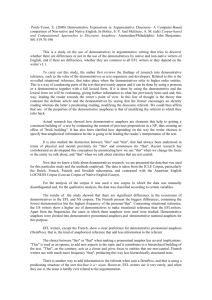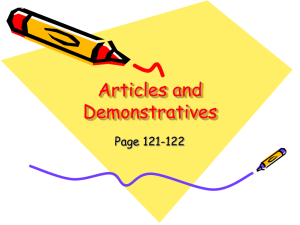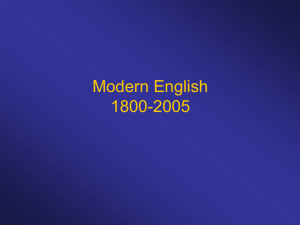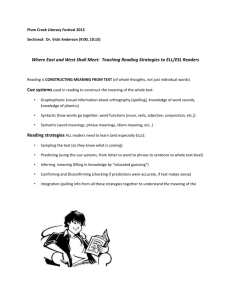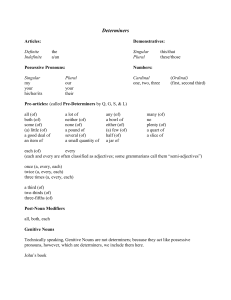Comparative Analysis of Semantic and Morphosyntactic Peculiarities of the
advertisement
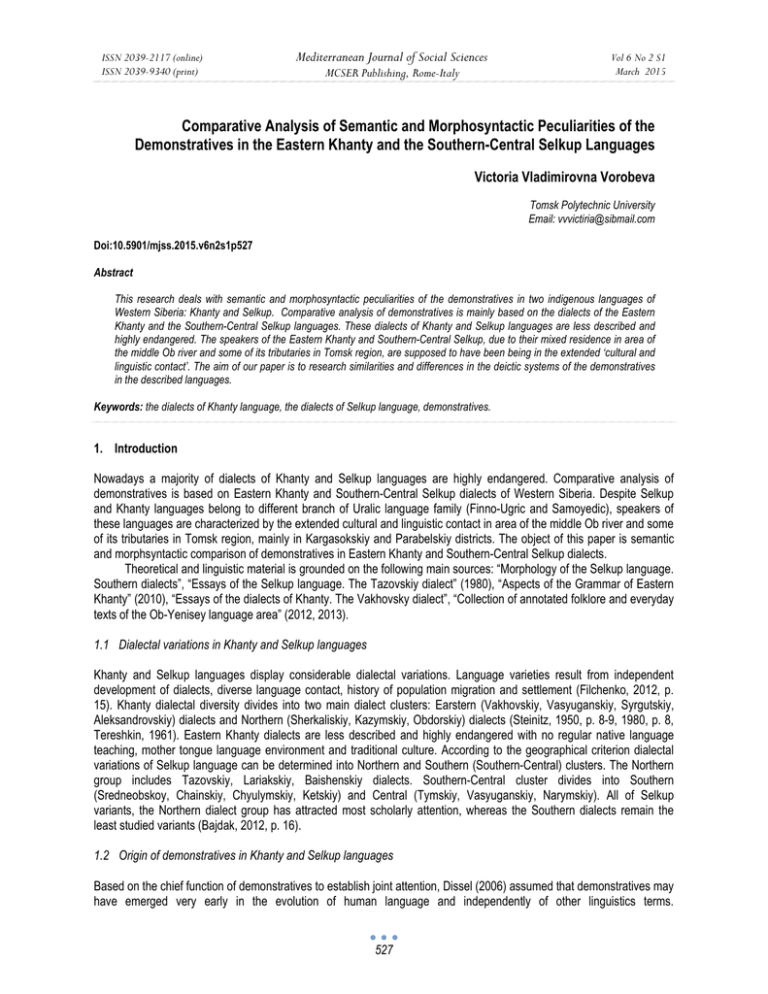
ISSN 2039-2117 (online) ISSN 2039-9340 (print) Mediterranean Journal of Social Sciences MCSER Publishing, Rome-Italy Vol 6 No 2 S1 March 2015 Comparative Analysis of Semantic and Morphosyntactic Peculiarities of the Demonstratives in the Eastern Khanty and the Southern-Central Selkup Languages Victoria Vladimirovna Vorobeva Tomsk Polytechnic University Email: vvvictiria@sibmail.com Doi:10.5901/mjss.2015.v6n2s1p527 Abstract This research deals with semantic and morphosyntactic peculiarities of the demonstratives in two indigenous languages of Western Siberia: Khanty and Selkup. Comparative analysis of demonstratives is mainly based on the dialects of the Eastern Khanty and the Southern-Central Selkup languages. These dialects of Khanty and Selkup languages are less described and highly endangered. The speakers of the Eastern Khanty and Southern-Central Selkup, due to their mixed residence in area of the middle Ob river and some of its tributaries in Tomsk region, are supposed to have been being in the extended ‘cultural and linguistic contact’. The aim of our paper is to research similarities and differences in the deictic systems of the demonstratives in the described languages. Keywords: the dialects of Khanty language, the dialects of Selkup language, demonstratives. 1. Introduction Nowadays a majority of dialects of Khanty and Selkup languages are highly endangered. Comparative analysis of demonstratives is based on Eastern Khanty and Southern-Central Selkup dialects of Western Siberia. Despite Selkup and Khanty languages belong to different branch of Uralic language family (Finno-Ugric and Samoyedic), speakers of these languages are characterized by the extended cultural and linguistic contact in area of the middle Ob river and some of its tributaries in Tomsk region, mainly in Kargasokskiy and Parabelskiy districts. The object of this paper is semantic and morphsyntactic comparison of demonstratives in Eastern Khanty and Southern-Central Selkup dialects. Theoretical and linguistic material is grounded on the following main sources: “Morphology of the Selkup language. Southern dialects”, “Essays of the Selkup language. The Tazovskiy dialect” (1980), “Aspects of the Grammar of Eastern Khanty” (2010), “Essays of the dialects of Khanty. The Vakhovsky dialect”, “Collection of annotated folklore and everyday texts of the Ob-Yenisey language area” (2012, 2013). 1.1 Dialectal variations in Khanty and Selkup languages Khanty and Selkup languages display considerable dialectal variations. Language varieties result from independent development of dialects, diverse language contact, history of population migration and settlement (Filchenko, 2012, p. 15). Khanty dialectal diversity divides into two main dialect clusters: Earstern (Vakhovskiy, Vasyuganskiy, Syrgutskiy, Aleksandrovskiy) dialects and Northern (Sherkaliskiy, Kazymskiy, Obdorskiy) dialects (Steinitz, 1950, p. 8-9, 1980, p. 8, Tereshkin, 1961). Eastern Khanty dialects are less described and highly endangered with no regular native language teaching, mother tongue language environment and traditional culture. According to the geographical criterion dialectal variations of Selkup language can be determined into Northern and Southern (Southern-Central) clusters. The Northern group includes Tazovskiy, Lariakskiy, Baishenskiy dialects. Southern-Central cluster divides into Southern (Sredneobskoy, Chainskiy, Chyulymskiy, Ketskiy) and Central (Tymskiy, Vasyuganskiy, Narymskiy). All of Selkup variants, the Northern dialect group has attracted most scholarly attention, whereas the Southern dialects remain the least studied variants (Bajdak, 2012, p. 16). 1.2 Origin of demonstratives in Khanty and Selkup languages Based on the chief function of demonstratives to establish joint attention, Dissel (2006) assumed that demonstratives may have emerged very early in the evolution of human language and independently of other linguistics terms. 527 Mediterranean Journal of Social Sciences ISSN 2039-2117 (online) ISSN 2039-9340 (print) Vol 6 No 2 S1 March 2015 MCSER Publishing, Rome-Italy Demonstratives of the described languages historically originated from protouralic deictic bases *t-, *n- (Vértes, 1967, 191-192; Décsy, 1990, p.5). Reflexes of the stem *t- are observed as in Khanty demonstratives as in Selkup demonstratives. Compare: khanty vakh. tim(i) ‘this’ - tom(Ƴ) ‘that’ and selkup ket. taw ‘this’ - to(na) ‘that’. Khanty demonstratives tҋ’i(t), tҋ’u(t) are derived from protofinno-ugric sten *s-, which was formed in results of alternation with protouralic stem *t- (*t- >*s-). Deictic base*n- was reconstructed by G. Décsy (1990, p 57), whose to Majtinskaja (1979) opinion was less used in Protouralic than *t-. Reflexes of this base are traced in Selkup demonstrative pronoun na(wga) ‘this’. 2. Semantic and Morphosyntactic Peculiarities of the Demonstratives in Eastern Khanty and Southern-Central Selkup 2.1 Forms of the demonstratives The deictic system of demonstratives in Eastern Khanty organized in paradigms of two contrastive pairs: vakh. tim(i) ‘this’ - tom(Ƴ) ‘that’, vas. tem(i) ‘this’ - tom(Ƴ) ‘that’ and vakh.-vas., surg. Ģi(t) ‘this’ - vakh.-vas., surg. Ģu(t) ‘that’ (Tereshkin, 1961, p. 67-68; Gulya, 1966, 74-77, Filchenko, 2010, p. 33). Table ʌ 1. Demonstratives of Eastern Khanty Dialects Vakhovskiy Vasyuganskiy Vakh-Vasyuganskiy Proximal tim(i) tem(i) t’ݕi(t) Visible Visible Invisible Distal tom(ܺ) tom(ܺ) t’ݕu(t) Vasyuygan Khanty usage of demonstratives: tem t`ιȖιjnι iȖ ju`näȘkι jι`l'il'wιl (Filchenko, 2013, p. 150). – ‘In this place a bear is constantly walking’. tom pel'kι min `untҋιwta (Filchenko, 2013, p. 150) – ‘To that side two of us take’. ι`kuntѰ jo`Ȗomamιn tҋu tι`Ȗιja…. (Filchenko, 2013, p. 142) – ‘When got to that place…’. tҋ’i köl` jol`oȖtalnι…. (Filchenko, 2013, p.148) - ‘This word say….’. Table ʌ 2. Northern Khanty employs three demonstratives (Rédei, 1968, p. 22; Steinitz, 1988 p. 1491-1492). Demonstrative of Northern Khanty Dialects Kazymskiy Sherkalskiy Proximal tăm(Ʊ) tăm(ԥ) Distal tǂm(Ʊ) tǂm(ԥ) Neutral ĞƱ(t) ĞƱ(t) The example from the Sherkalskiy dialect: ĞƱ tǎȘ ma kătȤǂĞjaȘ wǎnš wetsm (Radomski, 1989, p. 174). – ‘This summer I fished twelve white salmon’. In Southern Selkup the deictic system of demonstratives is presented by stems ta- ‘this’ – to-, a- ‘that’ and a stem n- ‘this’ (Bekker, 1995, p. 101-102). Table ʌ 3. Demonstratives of Southern-Central Selkup Dialects Ketskiy Sredneobskoy Tymskiy Vasyuganskiy Proximal taw, na(ti)~(w) taw, na taw, tap~tam, na taw(ga), na(wga) Medial aw aw(na) aw - Distal to(na)~(j) to(na) to(na)~(l’) to The next examples review the use of demonstratives in Southern Selkup. na tebelqum naʓʓakѰt tabѰn nadѰrѰldι (Filchenko, 2013, 192). – ‘This man will love her then’. taw kanak `kuҚan-naj `Ɨ muda (Filchenko, 2011, p. 136) – ‘This dog never barks’. 528 ISSN 2039-2117 (online) ISSN 2039-9340 (print) Mediterranean Journal of Social Sciences MCSER Publishing, Rome-Italy Vol 6 No 2 S1 March 2015 2.2 Spatial and temporal meaning of the demonstratives Demonstratives belong to deictic expressions of the language. Firstly, the deictic features of demonstratives are characterized in spatial terms based on their relationship to the deictic centre. The deictic centre is defined by the speaker’s location at the time of utterance. In Khanty and Selkup languages deictic words are egocentric. Eastern Khanty has two deictic pairs of demonstratives, contrasting proximal and distal referents, but in Southern-Central Selkup demonstratives indicate three different locations on a distance scale: proximal, medial, and distal. The sense of proximity or remoteness is explicit when terms are used contrastively. In Earstern Khanty language the first contrastive pair (vakh. tim(i) ‘this’ - tom(Ƴ) ‘that’, vas. tem(i) ‘this’ - tom(Ƴ) ‘that’) is uses for remarkable distance sense . For example, Khanty Vakh. tim iki lal’wιl, tom iki amιswιl (Gulay, 1966, p.138). – “This old man is sitting, that old man is standing”. In Southern-Central Selkup two terms with different spatial meaning aw(na) ‘that nearer’ and to(na)~l ‘that farer’ are used in contrast to term taw(ga) ‘this’. Look at the examples, Southern Selkup. taw qula tümbatti, aw qula kalatti (Bekker, 1995, p. 102). – ‘These people came, those people stayed’. taw mat šand, to mat t’ebi (Bekker, 1995. p.104). – ‘This house is new, that house is rotten’. However, in non-contrastive situation all demonstratives mentioned above save their inherent distance feature. In Eastern Khanty the second pare of demonstrative (tҋ’i(t) ‘this’ - tҋ’u(t) ‘that’) also indicates the location of the referent relative to the deictic centre. But there are situations where demonstratives tҋ’i(t) is changeable by tҋ’u(t). The example from Vasjugan Khanty: t’ݕu mƟȖ ƺata ălƳntιs (Gulya, 1989, p. 568). – ‘In this pit she lay down’. As can be seen in the example, tҋ’u is rather interpreted as a proximal term than as a distal one. The Selkup demonstrative na and its derivative forms naw, nagwa has not got a comparative pare and carries neutral feature (Bekker, 1995, p. 105). Though, demonstrative na is closer to some sense of proximity than to remoteness. Selkup Vasyugan na aȖa qut na kubѰl kudѰt elledѰt ellelѰmbadѰt nat ҸeRѰt (Bajdak, 2013, p.187). – ‘This is not people, this is souls of died people (which) live there’. Northern Khanty employs three deictic terms: tăm(Ʊ)~ (ԥ), tǂm(Ʊ)~(ԥ) and ĞƱ(t). Two of them are organized in contrastive forms indicating proximal and distal referents (tăm(Ʊ)~ (ԥ) ‘near speaker’ - tǂm(Ʊ)~(ԥ) ‘away from speaker’). In non-contrastive situations they also carry an inherent location meaning. Khanty Sherkalskiy năȘ uten, tăm ȤΗtιt jaȘ Ȥătl’ tƱtȘa uttιt (Radomski, 1989, p. 157). – ‘You know, these fish ten days live’. The demonstrative ĞƱ(t) is reserved for entities as near the speaker as away from speaker (Zhivotikov, 1942, p.7; Steinitz, 1937, p. 212; Rédei, 1968, p. 22). In Northern Khanty texts the demonstrative ĞƱ(t) is primarily met expressing proximal location of the referent to the speaker. Khanty Kazymskiy ĞƱ pǂrmιsιt Ʊntam woȜȜtιt mΗĞejιtιn (Rédei, 1968, p.32). – ‘These things keep in the museum’. In the next example from Khanty Kazymskiy text the term ĞƱ indicates distal referent to egocentric. ĞƱ ĞΗȜ-Ȥoten wos ƱĞƱkƱ, tΗt ăȜtƱ tăȤƱ an’ pa tăjιs (Rédei, 1968, p. 33-34). – ‘In that yurta was cold, there was no place for fire’. Maybe earlier demonstrative ĞƱ(t) had the contrastive pair, because some scientists W. Steinitz (1950), L. Honti (1984) mark term Ğut ‘away from speaker’ in Sherkalskiy Khanty, which is used only independently. Unfortunately, I didn’t succeed in meeting it in the available Northern Khanty texts. Thus, it is difficult to affirm existence of this form in nowadays Northern Khanty. To sum I believe that distance sense of the second comparative pare of Eastern Khanty demonstratives Ģi(t) - Ģu(t) ‘that’, Northern Khanty demonstrative ĞƱ(t) and Southern-Central Selkup na(wga) is sometimes vague. The demonstratives of the described languages can be imported not only into spatial domain, but also into the temporal one. Time is more elusive concept than space. In general, time is commonly conceptualized as motion in space. Spatial deictics are able to function to place an event on the time line relative to the moment of the speech event or moment of the utterance. Thus, demonstrative can function as spatial as temporal deictics. Although, demonstratives usually lose some of their deictic force when they express temporal sense (Yakovleva, 2012, p. 152). There are examples of temporal deixis from Vakh Khanty: mä tim aȜ kǂla joȖpa Čnt mιnlιm (Gulya, 1966, p. 81). – ‘This year I don’t go home’. tҋ’u al þČkι läȖιr wιlȖal (Tereshkin, 1961, p. 103). – ‘That year was very difficult’ 2.3 The meaning of visibility of the demonstratives In addition to distance, in Eastern Khanty the demonstratives indicate whether the referent is visible or invisible. In spite of the fact that visibility is not inherently deictic feature, in Eastern Khanty it is expressed by the same demonstrative terms. The first comparative pare is used for visible referent (vakh., vas. tim(i), tem(i) ‘near speaker visible’ - tom(Ƴ), tom(Ƴ) ‘away from speaker visible’) and the second comparative pare indicates the referent out-of-sight (vakh.-vas. Ģi(t) ‘near the speaker invisible’ - Ģu(t) ‘far away from speaker invisible’). I believe that due to the fact that the Vakh-Vasuygansky dialect is one of the most archaic (Collinder, 1960, p. 30; Décsy, 1965 p. 30; Bouda, 1972 p. 273), that’s why its system is richer. This dialect preserves relict phenomena (such as an ergative structure, a higher number of cases and times, visibility feature of demonstratives) distinguishing it from the other Khanty dialects and languages of the same branch of Uralic 529 ISSN 2039-2117 (online) ISSN 2039-9340 (print) Mediterranean Journal of Social Sciences MCSER Publishing, Rome-Italy Vol 6 No 2 S1 March 2015 family. K. Majtinskaya (1967) supposes that demonstratives’ referring to visible/invisible objects in Eastern Khanty and some dialects of Saam language developed under influence of Nenets language, where pronoun takι characterizes visibility of referent (p. 147). In the work “Essays of the Selkup language” (1980) authors made timid supposition that demonstrative tönna in tazovskiy dialect can indicate referent located very far from speaker and even invisible (p. 294). Thus, it may be supposed that earlier Southern-Central Selkup demonstrative to(na) ‘more remote’ might have similar semantic feature, as for a long time Southern Selkups and Eastern Khanties have been having lingual and cultural contact. 2.4 Syntactic forms of the demonstratives In the Southern-Central Selkup and the Eastern Khanty languages the demonstratives function as pronouns, that is independently or as nominal modifiers, that is in syntactic dependence from head nouns. Thus we can say about the demonstratives pronouns and demonstratives determiners. But in both cases of use the demonstratives are united by reference, needed to be relative to the referent. In Khanty more typically the demonstratives robustly collocate with nouns (Filchenko, 2010, p. 134), taking in these cases ‘short’ forms (vakh. tim ‘this’ - tom ‘that’, vas. tem ‘this’ – tom ‘that’ and vakh.-vas., surg. Ģi ‘this’ - vakh.-vas., surg. Ģu ‘that’, kaz., sherk. tăm ‘this’ – tǂm ‘that’, ĞƱ ‘this’). The demonstratives determiners are not marked for number and case, whereas the head noun carries the case agreement inflection. For instance, Eastern Khanty. tom pιlιk-nι - ‘on that side’, tҋ’u puȖl-a – ‘in that country’, tim iki – this old man’, Northern Khanty Ği aj – ‘this boy’. Vasyugan Khanty tҋ’i wer manna `ippι `nomlim (Filchenko, 2013, p. 151). – ‘This story I still remember’. The Easteren Khanty demonstratives pronouns have a ‘full’ form being added the morphemes -i~Ѱ (tom – tomѰ) or -t (tҋ’u - tҋ’ut) and the Northern Khanty demonstratives being added the morpheme -Ʊ~ι (tăm – tămƱ) or –t (ĞƱ - ĞƱt). The example of independent usage from Vakh Khanty: timi tomѰ mČta kölp Ɵntԥ tܺȖԥtԥs (Steinitz, 1988, p. 1392). – ‘Not this not that said words’. The example from the Kazymskiy Northern Khanty dialect: ĞƱt Εpİm ΑntҔ (Solovar, 2009, p. 35) - ‘This is not my sister’. Being used independently the demonstratives can be inflected for cases and numbers. Though, inflected forms of demonstratives are rarely occurred. The next example from Vakh Khanty shows a rare use of the demonstrative in the comitative case: tҋ’it-na mιnä! (Gulya, 1966, p. 78). – ‘Go with this!’ In some Southern Selkup dialects the use of the monosyllabic demonstratives aw, to, tol' only in modifying function with noun phrase is also fixed: taw qula tümbatti, aw qula kalatti (Bekker, 1995, p. 102). – ‘These people came, but that people stayed’. The next Southern Selkup mono-syllabic and two-syllabic demonstratives can be used as pronouns and determiners: taw, na, awna, tona. The following two examples show the demonstratives taw, tona and na in independent function in Southern Selkup: taw man, tona tebѰm (Bekker, 1995, p. 103). – ‘This – mine, that – yours.’ Sredneobskoy Selkup na qaj Ư na pƝge (Selection, 1980, p. 010). – ‘This is what son this is a hazel-grouse. The example of using demonstrative na as a determiner in the Narymskiy Central Selkup dialect: na ƝdЇget kan`ala `netuk (Filchenko, 2011, p. 084). – ‘In this village there are no dogs ’. The Southern Selkup demonstrative to-na-na, formed by reduplication of the second stem, and demonstratives tawga, naw/nagwa and nati, derived from taw and na, met only independently. Southern Selkup tep tunut tawgam (Bekker, 1995, p. 103). – ‘He doesn’t know this’. According to the regularity of the Tazovsiy Northern Selkup dialect, adding the morpheme –my to the demonstratives in the independent function is obliged: tam - tam-my, tǀnna – tǀnna-my (Kuznezova, 1980, p. 295). As in the Khanty language, the Selkup demonstratives in independent usage can be inflected for cases and numbers. Southern Selkup man tonanaRƳn aBƳrgu mel’l’eb’e (Bekker, 1995, p. 107). – ‘I those (two people) food gave’. Thus using independently the Khanty and Northern Selkup demonstratives are regularly marked by special fixed suffixes. Inflection of the demonstratives rarely takes place in Khanty and Selkup. In Selkup there are no special suffixes for building independent forms of the demonstratives but those which used only independently have longer forms. 2.5 Cases of anaphoric use of the demonstratives It is worth noting that the demonstratives pronouns in the described languages using independently can be met in anaphoric usage. Demonstratives occur in anaphoric and deictic uses. Surely, anaphoric uses are based on deictic ones (Paducheva, 2001, 133-136). In the deictic use demonstratives focus on a concrete referent, for instance, Vakh Khanty söȖιs wălȖal. mä tҋ’i söȖιsnι kä klaskιnnι onιltιȖιlȖalιm (Gulya, 1966, p. 136). – ‘It was autumn. In this autumn I studied in my first year'. Anaphoric demonstratives function to shift the interlocutors’ attention on a referent in previous context. Kazymskiy Northern Khanty tuȤaá măt’na tăjá, Ğit wǂn Ȥir Ȥurasup (Kaksin, 2014, p. 183). The example shows that the demonstrative Ğit is referential with the previous context tuȤaá măt’na tăjá. ‘A sweep-net has a purse; this is 530 ISSN 2039-2117 (online) ISSN 2039-9340 (print) Mediterranean Journal of Social Sciences MCSER Publishing, Rome-Italy Vol 6 No 2 S1 March 2015 something like a big sack’. In the following examples from the Vasyugan Khanty dialect the demonstrative temi is not referential with a concrete antecedent, but it drives hears to the background of knowledge received from the previous context. nomƳȖslm: “mƟtäli temi os äl pitwιl” (Honti, 1984, p. 141). – ‘I think: nothing of this would happen’. a temi ni `möܵtԥk, ni pԥ`t ܺݕ, ni` aܵԥrnԥƾ, ni` sart ԥnt`ԥm wԥl`qal (Filchenko, 2008). – ‘But here, there was no dace, no rudd, no ide, no pike. Thus, using independently demonstratives can receive additional shadow of meaning. 3. Concluding Remarks The deictic system of demonstratives in Khanty and Selkup dialects includes a different number of terms. It may range from three terms (Northern Khanty dialects) to six ones (Southern Selkup dialects). Demonstratives in described languages express temporal and spatial correlations relative to the deictic center or to the moment of speech. In Southern-Central Selkup the demonstratives indicate three different positions on a distal scale (proximal, medial and distal). In addition to distance and time, contrastive pairs of demonstratives in Eastern Khanty are imported into the additional meaning of visibility. Although, visibility is not inherently deictic feature, it is expressed by the demonstratives. We suppose there are demonstratives with a neutral sense as in Southern-Central Selkup as in Khanty dialects, which express more sense of proximity, but it is not always explicit. The demonstratives in Khanty have dependent or independent forms. The demonstratives that are used independently are morphologically distinguishable. In Southern Selkup there no special morphemes for constructing independent forms, but as a rule the demonstratives consisting of two or more syllables are used independently. More typically the demonstrative are used dependently in modifying function with noun phrase. In this case they carry deictic reference, focusing on a concrete entity. Being used independently the demonstratives are loose from syntactic dependence of head nouns and occur in anaphoric usage. References Bekker E. G., Alitkina L. A., Bykonya V. V., Ilyashenko I. A. (1985). Morphology of Selkup: Southern dialects (2nd part). Tomsk. Bouda K. Neues ostjakisches Material vom Vasjugan (1972). ALH. T. 22 (3-4), 273-280. Collinder B. (1960). Comparative Grammar of the Uralic Languages. Stockholm: Almqvist & Wiksell. Décsy G. (1990). The Uralic Protolanguage: A Comprehensive Reconstruction. Bloomongton, Indiana, USA 474002-0101. Diessel H. (2006). Demonstratives, joint attention, and the emergence of grammar // Cognitive Linguistics, Vol.17, 463–489. Filchenko A. (2008). The Eastern Khanty narratives (The Vasyugansky dialect). The Field Archive of the department of Siberian Indigenous Languages of TGPU. Filchenko A. (2010). Aspects of Grammar of Eastern Khanty. Tomsk: TGPU. Gulya J. (1966). Eastern Ostyak Chrestomathy. Bloomington. The Hague: Indiana University. Filchenko A., Bajdak A., Kryukova E. (2012). Collective monograph. Collection of annotated folklore and everyday texts the Ob-Yenisey language area. Tomsk: Agraf-Press. Filchenko A., Bajdak A., Kryukova E. (2013). Collective monograph. Collection of annotated folklore and everyday texts the Ob-Yenisey language area. (3rd ed.). Tomsk: Vajar. Gulya, J. (1989). Grindköpfige; AĐwali; Der Spatz und seiner Schwester. Steinitz W. Ostjakologische Arbeiten. Berlin: Akademie-Verlag. (Bd. III), 567-569. Honti L. (1984). Chrestomathia Ostiacica. Budapest: Tankönyvkiadó. Karjalainen K.F. (1948). Ostjakisches Wörterbuch bearbeitet und herausgegeben von Y.H. Toivonen. Helsinki (T. II). 561-1199. Kaksin A.D. (2014). Comparative constructions in Khanty language: inventory, typology, characteristics: reports of the All-Russian scientific conference (Petrozavodsk, the 25-28th of June 2014). Petrozavodsk, 182-185. Kuznetsova A. I., Khelimskiy E.A., Grushkina E.V. (1980). Essays of the Selkup language. (Tazovskij dialect). (vol. I). Moscow: Moscow university. Majtinskaya K.E. (1967). Semantics of demonstratives in Finno-Ugric languages. Issues of Finno-Ugric linguistics.Izhevsk: Udmurtia. (Vol. IV). 143-148. Majtinskaya K. E. (1979). Historico-comparative Morphologe of Finni-Ugric languages. M.: Nauka. Paducheva E.V. (2001). Statement and its relation with reality (referential aspects of demonstratives’ semantics). Ɇ: Editorial URSS. Filchenko A. (2011). Questionnaire “Negation” (Southern Selkup), adopted in 2011 in the river Parabel. The Field Archive of the department of Siberian Indigenous Languages of TGPU. Radomski (1989). R. Der Zar und die Zarin; Aus dem Leben K. I. Maremjanis.Steinitz W. Ostjakologische Arbeiten. Akademie-Verlag: Berlin. (Bd. III). 3-29; 131-200. Rédei K. (1968). Nord – Ostjakische Texte (Kazym Dialekt) mit Skizze der Grammatik. – Göttingen: Vandenhoece & Ruprecht. Solovar V.N. (2009). A paradigm of a simple sentence in Khanty language. Novosibirsk: Lyubava. Kim Ⱥ., .Maksimova ɇ. (1980). Selection “How a hazel-grouse became a living being” (Southern Selkup), written down in 1980, adopted and translated in 2010 [A. Bajdak, ɇ .Maksimova, H. Fedotova]. The Field Archive of the department of Siberian Indigenous 531 ISSN 2039-2117 (online) ISSN 2039-9340 (print) Mediterranean Journal of Social Sciences MCSER Publishing, Rome-Italy Vol 6 No 2 S1 March 2015 Languages of TGPU. Steinitz W (1950). Ostiakische Grammatik und Chrestomathie mit Wörterverzeichnis (Scherkaler dialekt). – Leipzig: Otto Harrassowitz. Steinitz W. (1980). Ostjakologische Arbeiten. Berlin: Akademie–Verlag. Bd. IV. Steinitz W. (1988). Dialektologisches und Etymologisches Wörterbuch der Ostjakischen Sprache (12 Lieferung). Berlin: Academie – Verlag. 1377-1504. Tereshkin N. I. (1961). Essays of Khanty language dialects (1st part). The Vakhovskiy dialect. Moscow-Leningrad. Tereshkin N. I. (1981). Dictionary of Eastern Khanty dialects. Leningrad. Vértes E. (1967). Die Ostjakischen Pronomina. Budapest: Akadémiai Kiadó. Yakovleva E. (2012). Referential and non-referential using of Spanish demonstratives (ʋ 1). Vestnik TGPU. 152-156. Zhivotokov P. (1942). Essays of Khanty language dialects (the Sredneobskoiy dialect). Khanty-Mansiisk. 532
